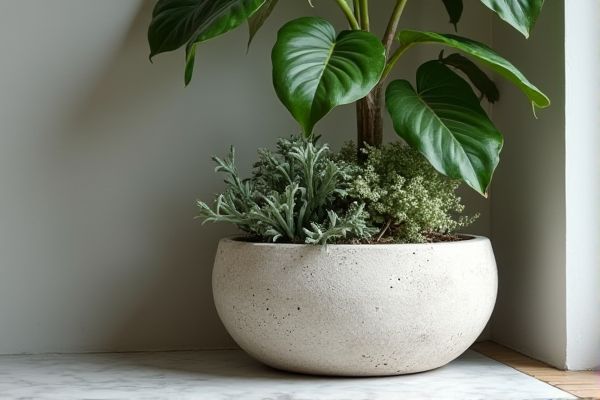
Concrete planters offer superior durability and insulation for outdoor plants, while ceramic planters provide elegant designs and better moisture retention for indoor gardening. Discover how to choose the perfect planter to enhance Your garden by reading the rest of the article.
Table of Comparison
| Feature | Concrete Planter | Ceramic Planter |
|---|---|---|
| Material | Pressed or poured concrete | Glazed or unglazed fired clay |
| Weight | Heavy, very durable | Light to medium weight |
| Durability | High resistance to weather and cracking | Can chip or crack, less impact-resistant |
| Porosity | Low porosity, retains moisture well | Varies; glazed is less porous, unglazed absorbs water |
| Insulation | Good thermal mass, protects roots from temperature swings | Poor thermal insulation compared to concrete |
| Design Options | Modern, industrial look; customizable shapes | Traditional to decorative; wide color range |
| Cost | Moderate to high | Low to moderate |
| Maintenance | Low; may need sealing over time | Fragile; careful handling required |
| Best Use | Outdoor and large plants, durable landscape projects | Indoor use, decorative plants, patios |
Introduction to Concrete and Ceramic Planters
Concrete planters are known for their durability, heavy weight, and industrial aesthetic, making them ideal for outdoor use and large plants requiring stability. Ceramic planters offer vibrant color options, smooth textures, and a more refined appearance, suitable for indoor settings and decorative purposes. Your choice depends on the desired style, weight tolerance, and environmental conditions where the planter will be placed.
Material Composition and Durability
Concrete planters are made from a mixture of cement, sand, and aggregates, providing exceptional durability and resistance to weathering, making them ideal for outdoor use. Ceramic planters, crafted from fired clay with a glazed or unglazed surface, offer moderate durability but are more susceptible to cracking under extreme temperature changes. The dense, heavy nature of concrete ensures long-lasting structural integrity, while ceramic planters prioritize aesthetic appeal but require careful handling to prevent damage.
Aesthetic Appeal and Design Options
Concrete planters offer a modern, industrial aesthetic characterized by their raw, textured surfaces and sturdy appearance, making them ideal for minimalist or urban designs. Ceramic planters provide a broader range of colors, glossy finishes, and intricate patterns, allowing for more vibrant and decorative styles that complement traditional or eclectic interiors. Choosing between the two depends on your preferred design theme and whether you prioritize the rugged charm of concrete or the artistic versatility of ceramic.
Weight and Portability Comparison
Concrete planters are significantly heavier than ceramic planters, making them less portable and more suitable for permanent outdoor placements. Ceramic planters offer a lighter alternative, allowing you to easily move and rearrange your plants indoors or on patios. Your choice depends on whether durability or mobility is a priority for your garden setup.
Drainage and Moisture Control
Concrete planters excel in moisture retention due to their porous nature, allowing slow evaporation and reducing the frequency of watering. Ceramic planters often feature drainage holes and a glazed interior that prevents water absorption, providing superior drainage and preventing root rot. Choosing between them depends on the plant species' water requirements and the planter's ability to control moisture effectively.
Temperature Regulation for Plant Health
Concrete planters excel in temperature regulation by providing superior insulation that protects plant roots from extreme heat and cold, maintaining a stable root environment. Ceramic planters, while aesthetically pleasing, tend to retain less heat and cool down quicker, potentially exposing roots to temperature fluctuations. This temperature stability in concrete planters supports healthier root development and reduces stress on plants, especially in variable climates.
Cost and Affordability
Concrete planters generally offer greater affordability due to their durable materials and longer lifespan, making them cost-effective for long-term use. Ceramic planters tend to be more expensive upfront because of their intricate designs and glazing processes, but their aesthetic appeal can justify the higher cost for decorative purposes. Budget-conscious buyers often prefer concrete planters for outdoor settings, while ceramic options suit indoor environments where style takes precedence over durability.
Maintenance Requirements
Concrete planters require minimal maintenance due to their durability and resistance to weather conditions, making them ideal for outdoor use. Ceramic planters demand more care to prevent chipping and cracking, especially when exposed to extreme temperatures or handling. Your choice should consider how much time you are willing to invest in upkeep to keep your plants thriving.
Eco-Friendliness and Sustainability
Concrete planters are highly durable and long-lasting, reducing the need for frequent replacements and lowering overall environmental impact through their extended lifecycle. Ceramic planters, while often made from natural clay and more biodegradable, typically require more energy in the firing process, affecting their carbon footprint. Choosing sustainable materials and production methods enhances eco-friendliness for both types, but concrete's robustness usually results in greater long-term sustainability.
Best Uses and Recommendations
Concrete planters offer exceptional durability and insulation, making them ideal for outdoor spaces and larger plants requiring stable root environments. Ceramic planters provide excellent moisture retention and aesthetic appeal, perfect for indoor settings and decorative houseplants. You should choose concrete planters for heavy-duty, weather-resistant needs and ceramic planters to enhance your interior design with vibrant, moisture-loving plants.
 homyna.com
homyna.com